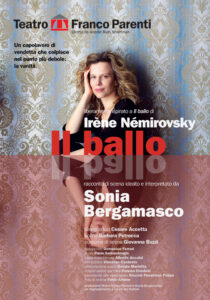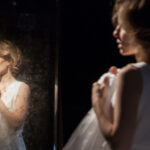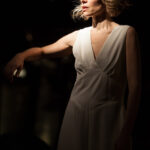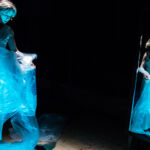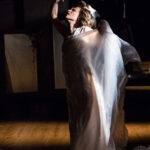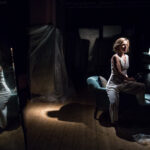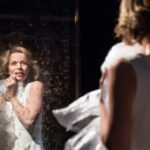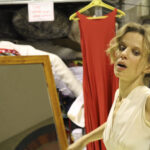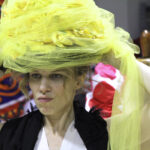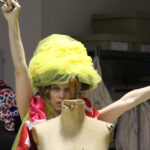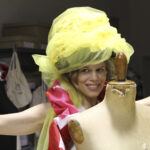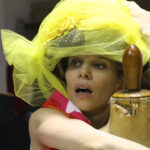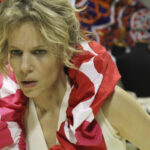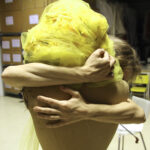The Ball
a staged story conceived and performed by Sonia Bergamasco
loosely based on “Il Ballo” (The Ball) by Irène Némirovsky The Ball by Irène Némirovsky
scenes Barbara Petrecca
lighting design Cesare Accetta
costume Giovanna Buzzi
Performed in Milan at Teatro Franco Parenti - 5 March 2015
DIRECTOR'S NOTES
I am like a room with innumerable fantastic mirrors that distort by false reflections one single pre-existing reality which is not there in any of them and is there in them all.
Fernando Pessoa
The words of one poet decipher the words of another. The secretive, misanthropic Portuguese artist sheds light – obliquely and unintentionally – on a stunning piece of work by a Parisian writer of Russian origins. It is the intuition of Fernando Pessoa that leads the dance and runs the game. There is no parallelism, no analogy between the stories by the two writers. Simply put, it is his incandescent gaze that captures and recounts better than any discourse the staged event that animates The Ball. As Pessoa said: to pretend is to know oneself – the game of acting, the game of staging. And sincerity is a big obstacle that the artist has to surmount (Irène Némirovsky seems to have inscribed this statement in her secret diary when she recounted, in a labyrinth of variations and intrigues, always the same saga, the same story of failed love, the same agony). But then Irène noted in the margins: An unhappy childhood is like an unburied body, groaning forevermore.
Within the haunted room – in the game of glances and spell of the fairytale – there is also, especially for me, the desire to share a story – i.e. theater – and even before that, the love of reading, that silent treasure trove full of voices, the origin and driving force of Eros. With Il Ballo, Irène Némirovsky bursts onto the writing scene with the force of a grenade. In this tale of her youth, she makes an explosive inventory of all the most personal voices of her anger, hatred and disenchantment. She does so, for her part, without skimping on plot twists and without denying herself spectacle. Behind the image reflected in the mirror, the poignant echo of that unforgiving little girl. And once again, Pessoa says it better than anyone else:
The poet is a pretender,
he pretends so completely
that he comes to pretend the pain
he really feels is pain.
.
- Interview to Sonia Bergamasco by Antonella Frontani, 14 March 2018
- "Il talento di Sonia dà ritmo al “Ballo” by Magda Poli, 22 March 2018
- "Il ballo" by Rodolfo di Giammarco - la Repubblica, 20 January 2016
- "Il Ballo" by Gabriele Ottaviani, Convenzionali - 24 January 2016
- Il «Ballo» amaro e magnifico di Sonia Bergamasco by Leonardo Mello - Venezia Musica e e dintorni - 6 December 2015
- "Sonia Bergamasco si guarda allo specchio e scopre la Némirovsky" by Anna Bandettini, La Repubblica - 29 March 2015
- "IL BALLO" by Maria Ester Equi, Associazione Vox - 17 March 2015
- "Cinque volte Némirovski" by Renato Palazzi, Il Sole 24 ore - 15 March 2015
- "Un raffinato lavoro teatrale presentato da una ineccepibile Sonia Bergamasco" by Alberto Raimondi, Central Palc - 15 March 2015
- "Sonia, una Cenerentola al contrario" by Giuseppe Paternò di Raddusa, Cultweek- 13 March 2015
- "Il ballo" by Raffaella Roversi, Saltinaria.it - 13 March 2015
- "La figlia si vendica, disfatta di una madre" by Magda Poli, Corriere della Sera - 12 March 2015
- "Sonia balla da sola" by Maria Grazia Gregori, delteatro.it - 5 March 2015
The Ball - preparatory study (2013)
Solitude and the Mirror
An unhappy childhood is like a lost soul,
unburied and moaning forever.
In her story “Il ballo (The Ball), Irène Némirovsky reinterprets the tale of Cinderella, flogging its symbols and structure in order to strike to the heart with the weapons of revenge. Extreme revenge, with no forgiveness for the mother, driven by the loneliness and lack of love suffered by the daughter – Antoinette/Cinderella. A Cinderella who after fourteen years of lovelessness, vents her rage on her mother’s body at its most vulnerable point – namely, on the desire for social payback and success of a woman who is no longer young.
Antoinette experiences being forbidden to attend the first ball organized by her parents – rich, vulgar Jews - in their big new house, as the ultimate insult, so she makes sure the ball never takes place. She secretly rips up the invitations and throws them into the Seine, with ferocious determination. This is her revenge. There will be no Prince Charming, neither for her nor for her mother, who is yearning for social redemption. There will be no beautiful dresses and dancing slippers. On the fateful evening, everything is in readiness for the party, but no one is going to ring at the door and the mother/witch will succumb to the most horrific humiliation without ever knowing the real reasons for the fiasco.
Images of the mother and the daughter square off, in this last moment of truth and falsehood, and are reflected in a reversal of roles that is also the recognition of a deep, violent kinship.
.
